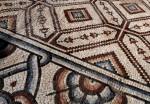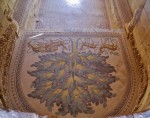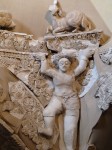 For one time only, the glorious 8th century mosaic floor of Khirbat al-Mafjar, colloquially known as Hisham’s Palace, was on view in all its colorful majesty on Thursday, October 20th. The floor features 38 different scenes in 21 colors, and at 825 square meters (8,900 square feet), it is one of the largest mosaic floors in the world.
For one time only, the glorious 8th century mosaic floor of Khirbat al-Mafjar, colloquially known as Hisham’s Palace, was on view in all its colorful majesty on Thursday, October 20th. The floor features 38 different scenes in 21 colors, and at 825 square meters (8,900 square feet), it is one of the largest mosaic floors in the world.
 Discovered in 1873 three miles north of the West Bank city of Jericho, the first excavations of the site took place between 1934 and 1948 under the direction of Palestinian archaeologist Dimitri Baramki. The palace got its name from a marble ostracon that was discovered during the Baramki excavations that had “Hisham” scratched on it. The name on the marble fragment suggested that the lavish mansion may have been built during the reign of the 10th Umayyad caliph Hisham ibn Abd al-Malik (r. 724-743). The name stuck even though the palace may not have been built for the caliph himself. Robert Hamilton, the British colonial administrator and a colleague of Baramki’s, proposed the compound was constructed for the Hisham’s nephew and successor Walid ibn Yazid (r. 743-744) whose notorious love of the high life irritated the hell out his more temperate uncle.
Discovered in 1873 three miles north of the West Bank city of Jericho, the first excavations of the site took place between 1934 and 1948 under the direction of Palestinian archaeologist Dimitri Baramki. The palace got its name from a marble ostracon that was discovered during the Baramki excavations that had “Hisham” scratched on it. The name on the marble fragment suggested that the lavish mansion may have been built during the reign of the 10th Umayyad caliph Hisham ibn Abd al-Malik (r. 724-743). The name stuck even though the palace may not have been built for the caliph himself. Robert Hamilton, the British colonial administrator and a colleague of Baramki’s, proposed the compound was constructed for the Hisham’s nephew and successor Walid ibn Yazid (r. 743-744) whose notorious love of the high life irritated the hell out his more temperate uncle.
 Whoever it was built for, it had to have been someone in the royal family. The architecture, decorations and artifacts mark it as having been built under the Umayyad dynasty in first half of the 8th century. It’s in a category of structures known as the Umayyad desert castles, fortified palaces built near water sources in the arid regions of Jordan, Syria, Israel and the West Bank between 661 (when Damascus was made the Umayyad capital) and 750 A.D. (when the capital was moved to Baghdad).
Whoever it was built for, it had to have been someone in the royal family. The architecture, decorations and artifacts mark it as having been built under the Umayyad dynasty in first half of the 8th century. It’s in a category of structures known as the Umayyad desert castles, fortified palaces built near water sources in the arid regions of Jordan, Syria, Israel and the West Bank between 661 (when Damascus was made the Umayyad capital) and 750 A.D. (when the capital was moved to Baghdad).
 Like the other desert castles, Hisham’s Palace includes an agricultural enclosure and a bath complex supplied with water from a nearby oasis. The spectacular mosaics covered the floor of the main bath hall, and one of the most famous stand-out pieces, a Tree of Life mosaic, decorated the floor of the bath’s bahw, or special reception room. It depicts a fruit tree with two gazelles peacefully hanging out on the left, while a gazelle on the right side is attacked by a lion. The contrasting scenes of peace vs. combat are believed to represent the power of the caliph to either bring prosperity to his people or to ruthlessly repress them.
Like the other desert castles, Hisham’s Palace includes an agricultural enclosure and a bath complex supplied with water from a nearby oasis. The spectacular mosaics covered the floor of the main bath hall, and one of the most famous stand-out pieces, a Tree of Life mosaic, decorated the floor of the bath’s bahw, or special reception room. It depicts a fruit tree with two gazelles peacefully hanging out on the left, while a gazelle on the right side is attacked by a lion. The contrasting scenes of peace vs. combat are believed to represent the power of the caliph to either bring prosperity to his people or to ruthlessly repress them.
 Elaborately carved stucco panels, mainly florals and geometrics with some animal and human figures, including semi-nude men and women, were also found in the bath complex. The stuccos are now at the Rockefeller Museum in East Jerusalem. The decorative elements in the desert castles are among the earliest Islamic art, and the mosaics, sculptures, frescoes and carved stucco features at Hisham’s Palace are of particularly high quality. The dizzying array of colors and patterns in the mosaics prefigure later Islamic design, while the figural art is unique to the Umayyad period.
Elaborately carved stucco panels, mainly florals and geometrics with some animal and human figures, including semi-nude men and women, were also found in the bath complex. The stuccos are now at the Rockefeller Museum in East Jerusalem. The decorative elements in the desert castles are among the earliest Islamic art, and the mosaics, sculptures, frescoes and carved stucco features at Hisham’s Palace are of particularly high quality. The dizzying array of colors and patterns in the mosaics prefigure later Islamic design, while the figural art is unique to the Umayyad period.
 The palace is the biggest tourist draw in the West Bank which has a major downside from a conservation standpoint. In addition to the tens of thousands of visitors stomping the site every year, Jericho’s urban sprawl, conflict and scant funds for preservation and personnel have placed Hisham’s Palace is in dire straights. In 2010, the non-profit Global Heritage Fund put it on a list of 12 sites on the verge of irreparable damage. The only mosaic on display in the Tree of Life in the reception room. The rest have been covered by soil and canvas almost since they were first unearthed.
The palace is the biggest tourist draw in the West Bank which has a major downside from a conservation standpoint. In addition to the tens of thousands of visitors stomping the site every year, Jericho’s urban sprawl, conflict and scant funds for preservation and personnel have placed Hisham’s Palace is in dire straights. In 2010, the non-profit Global Heritage Fund put it on a list of 12 sites on the verge of irreparable damage. The only mosaic on display in the Tree of Life in the reception room. The rest have been covered by soil and canvas almost since they were first unearthed.
 In September 2015, the Japan International Cooperation Agency signed a grant agreement with the Palestinian Authority to give up to 1.235 billion yen ($11,860,000) to construct a protective roof and exhibition facilities for the bath mosaics. The Palestinian Ministry of Tourism and Antiquities spent a year carefully removing the sand, soil and assorted debris covering the floor. Now that the construction phase is about to begin, the complete mosaic floor of the bath complex of Hisham’s Palace was uncovered for a day. The floors go back undercover until the project is complete. If all goes well, the newly protected and restored mosaics will be open to visitors by 2018.
In September 2015, the Japan International Cooperation Agency signed a grant agreement with the Palestinian Authority to give up to 1.235 billion yen ($11,860,000) to construct a protective roof and exhibition facilities for the bath mosaics. The Palestinian Ministry of Tourism and Antiquities spent a year carefully removing the sand, soil and assorted debris covering the floor. Now that the construction phase is about to begin, the complete mosaic floor of the bath complex of Hisham’s Palace was uncovered for a day. The floors go back undercover until the project is complete. If all goes well, the newly protected and restored mosaics will be open to visitors by 2018.
I visited Hisham’s palace way back in 1977 when the area was under Israeli control. Was a magnificent site. And the mosaic and paneling really exceptional as subsequent Arab Islamic art used no human forms. Saw the panels recently in the Rockefeller Museum. Beautiful. Here’s hoping that the Pa. Authority is successful in restoring and preserving the floor to its former glory.
Exquisite !! Thank you.
The Tree of Life mosaic is gorgeous and so well executed. I’d like to see better photographs of it.
There’s that has this photo of the Tree of Life mosaic.